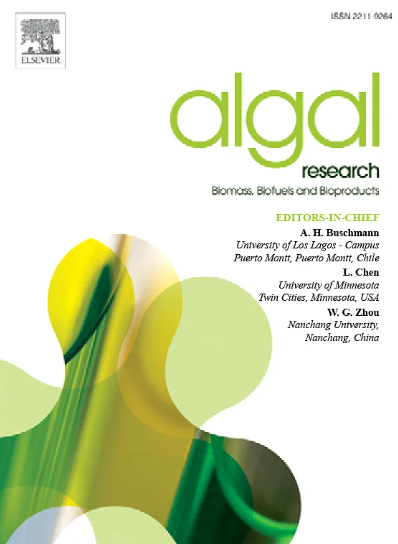Empty bed residence time regulates synergistic effect of algae-bacteria consortia in volatile organic compounds treatment: Performance and mechanism
IF 4.6
2区 生物学
Q1 BIOTECHNOLOGY & APPLIED MICROBIOLOGY
Algal Research-Biomass Biofuels and Bioproducts
Pub Date : 2025-05-26
DOI:10.1016/j.algal.2025.104113
引用次数: 0
Abstract
Biological treatment technology utilizing algal-bacteria consortium (ABC) has shown remarkable effectiveness in synergistically reducing emissions of volatile organic compounds (VOCs) and CO2. However, the impact of empty bed residence time (EBRT) on the performance and underlying synergistic mechanisms of the ABC has remained unclear. In this study, we systematically compared an algal-bacterial airlift photobioreactor (PB) with a conventional bacterial airlift bioreactor (CB) under varying EBRT conditions. At longer EBRTs of 51 and 34 s, both reactors achieved nearly 100 % removal efficiency (RE) for n-butyl acetate. Simultaneously, the activity of the Rubisco enzyme increased substantially, enhancing the CO2 assimilation efficiency () of the microalgae, which peaked at 92.65 ± 0.88 %. At shorter EBRTs of 26 and 20 s, the PB exhibited n-butyl acetate REs approximately 1.11 and 1.46 times higher than the CB, respectively. Notably, shorter EBRT stimulated the ABC to secrete more extracellular polymeric substances (EPS) and promoted the formation of more complex microbial communities, thereby ensuring more stable and efficient pollutant removal. It is demonstrated in this work that synergistic reductions of VOCs and CO2 across various environmental conditions can be effectively achieved by the ABC, providing valuable theoretical insights for the development of gas bio-purification technologies.
空床停留时间调节藻菌联合体在挥发性有机物处理中的协同作用:性能与机制
利用藻菌联合(ABC)的生物处理技术在协同减少挥发性有机化合物(VOCs)和CO2排放方面显示出显著的效果。然而,空床停留时间(EBRT)对ABC的性能和潜在协同机制的影响尚不清楚。在这项研究中,我们在不同的EBRT条件下系统地比较了藻-细菌气升式光生物反应器(PB)和传统细菌气升式光生物反应器(CB)。在较长的ebrt (51 s和34 s)下,两个反应器对乙酸正丁酯的去除率均接近100%。同时,Rubisco酶活性大幅提高,提高了微藻的CO2同化效率(RCO2),最高可达92.65±0.88%。在较短的ebrt(26和20 s)下,PB的乙酸正丁酯含量分别是CB的1.11倍和1.46倍。值得注意的是,较短的EBRT刺激ABC分泌更多的胞外聚合物质(EPS),促进形成更复杂的微生物群落,从而确保更稳定和高效的污染物去除。本研究表明,ABC可以有效地实现不同环境条件下VOCs和CO2的协同减排,为气体生物净化技术的发展提供了有价值的理论见解。
本文章由计算机程序翻译,如有差异,请以英文原文为准。
求助全文
约1分钟内获得全文
求助全文
来源期刊

Algal Research-Biomass Biofuels and Bioproducts
BIOTECHNOLOGY & APPLIED MICROBIOLOGY-
CiteScore
9.40
自引率
7.80%
发文量
332
期刊介绍:
Algal Research is an international phycology journal covering all areas of emerging technologies in algae biology, biomass production, cultivation, harvesting, extraction, bioproducts, biorefinery, engineering, and econometrics. Algae is defined to include cyanobacteria, microalgae, and protists and symbionts of interest in biotechnology. The journal publishes original research and reviews for the following scope: algal biology, including but not exclusive to: phylogeny, biodiversity, molecular traits, metabolic regulation, and genetic engineering, algal cultivation, e.g. phototrophic systems, heterotrophic systems, and mixotrophic systems, algal harvesting and extraction systems, biotechnology to convert algal biomass and components into biofuels and bioproducts, e.g., nutraceuticals, pharmaceuticals, animal feed, plastics, etc. algal products and their economic assessment
 求助内容:
求助内容: 应助结果提醒方式:
应助结果提醒方式:


